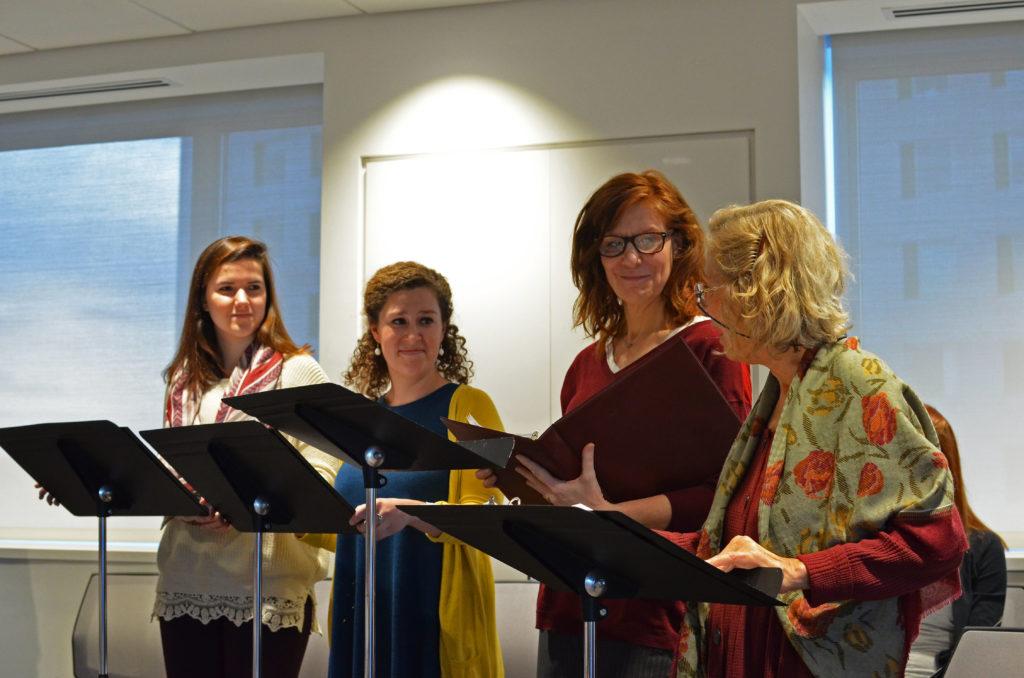By Kendall Heward, news correspondent
The Northeastern community gathered together to learn more about the Holocaust – through the eyes of one woman.
Each January, the university sets aside a week to raise awareness of the Holocaust through a series of speakers and events. This year, many of the events were focused on one survivor: Sala Garncarz.
Several events were held throughout the week, including the unveiling of an exhibition in International Village (IV), a staged reading of a play written about Sala’s life and a panel of artists who spoke about their involvement with Sala’s story.
At 16, Sala went to work in a Nazi labor camp for what she thought would be a six-week period. Instead, she spent over six years in Nazi camps, where she risked her life while sending and receiving letters from her friends and family. Sala was able to successfully hide these letters and eventually took them to America after her liberation.
For over 50 years, Sala kept her story and letters a secret until she decided to share them with her daughter Ann Kirschner. Understanding that her mother’s letters were of important historical significance, Kirschner decided to write a book, “Sala’s Gift,” about her mother’s time during the Holocaust. It was published in 2006.
“We can either be bystanders, stewards or active storytellers of history,” Kirschner said of her decision to share her mother’s story with the world.
Over the years, many other artists have joined Kirschner to bring this story to the public through a variety of mediums in order to reach the largest audience possible.
“We wanted to engage the public in different ways,” Kirschner said.
In addition to Kirschner’s book, artists have created a travelling installation, a play and an upcoming documentary about Sala’s life and experiences. Through each medium, another layer of Sala’s story is brought to life for the public to understand and learn from.
Ann Kirschner’s book details Sala’s time in the camps and Kirschner’s own feelings and thoughts about discovering her mother’s letters and fully realizing a part of her mother’s life that she hadn’t previously understood.
The travelling exhibit, currently housed in IV, displays Sala’s original letters in a comprehensive timeline so the viewer can follow her story through the historical documents.
Playwright Arlene Hutton’s play, Letters to Sala, was written to bring the characters throughout Sala’s experiences to life, and has been performed all over the country, including a staged reading held on Northeastern’s campus.
Murray Nossel’s upcoming documentary about Sala has been in the works for over 10 years and works to explore Sala’s life and personality through her many life experiences. These artists also expressed the importance of sharing this story with the public in order to keep history alive.
“The play is about our responsibility to the past and to keep these people alive,” Arlene Hutton, playwright of Letters to Sala, said.
Sala’s story scales down events like the Holocaust and World War II and makes them more personal. According to Kirschner, attaching a name and a face to an event immediately makes it more impactful.
“History needs a human face in order for us to understand it,” Kirschner said. Many Northeastern students echoed these sentiments while viewing different aspects of Sala’s story.
“I like the space of the exhibit with the natural light,” Amy Hood, fifth-year French and international affairs major, said. “[The exhibit] is very comprehensive, I feel like I’m learning a lot.”
According to Jill Vexler, curator of the exhibit, Sala’s story is one of hope and perseverance in the face of great adversity.
“Sala believed that if she held on to these letters, then she could live to see the people that wrote them,” Vexler said.
This hope kept Sala alive and will serve as inspiration for generations to come.
“Sala teaches us that you can survive, you can be happy, you can rebuild,” Vexler said.
Photo by Robert Smith









